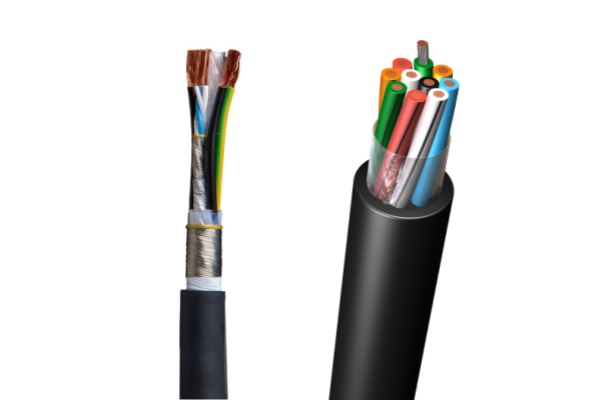

Kejbils ta 'kontroll huma komponenti essenzjali f'applikazzjonijiet industrijali, tiffaċilita l-komunikazzjoni, trasmissjoni tas-sinjal, u kontroll bejn makkinarju u sistemi ta 'awtomazzjoni. Mingħajr dawn il-kejbils, L-industriji moderni ma jaħdmux b'mod effiċjenti jew sigur. Dawn il-kejbils speċjalizzati huma mfassla biex jittrasmettu sinjali elettriċi b'interferenza minima, L-iżgurar ta 'operazzjonijiet preċiżi f'ambjenti varji, minn sulari tal-fabbrika għal settings ħarxa fil-beraħ.
F'dan l-artikolu, Veri Cable se tesplora t-tipi komuni ta 'kejbils ta' kontroll użati f'applikazzjonijiet industrijali, jiffokaw fuq id-disinn tagħhom, materjali, u l-ambjenti speċifiċi fejn kull tip huwa l-iktar adattat. Billi tifhem it-tipi differenti, In-negozji jistgħu jieħdu deċiżjonijiet infurmati biex jottimizzaw il-prestazzjoni, tnaqqas il-ħin ta 'waqfien, u ssaħħaħ is-sigurtà.


Il-kejbils tal-kontroll huma kejbils multi-kondutturi ddisinjati biex iġorru sinjali ta 'vultaġġ baxx għall-kontroll u r-regolazzjoni tat-tagħmir. Dawn il-kejbils huma tipikament użati fl-awtomazzjoni, Manifattura, enerġija, trasport, u industriji oħra fejn kontroll preċiż huwa essenzjali.
Huma differenti mill-kejbils tal-qawwa, li huma maħsuba biex iġorru kurrent elettriku, billi jiffokaw fuq l-integrità tas-sinjal u l-interferenza minima. Il- insulazzjoni u lqugħ ta 'kejbils ta' kontroll huma kruċjali biex jiżguraw li jittrasmettu sinjali mingħajr degradazzjoni jew interferenza tal-ħoss elettriku.
Issa, Ejja nesploraw id-diversi tipi ta 'kejbils ta' kontroll użati b'mod komuni f'applikazzjonijiet industrijali:
Klorur tal-polivinil (PVC) hija waħda mill-iktar materjali użati ħafna għall-kejbils tal-kontroll minħabba l-versatilità u l-kosteffikaċja tagħha. Kejbils tal-kontroll tal-PVC huma tipikament użati f'ambjenti industrijali fejn hija meħtieġa protezzjoni mekkanika u kimika moderata.
Il-kejbils tal-kontroll tal-PVC huma l-iktar effettivi f'ambjenti niexfa jew ħafifa u jistgħu jintużaw għal applikazzjonijiet ta 'stress mekkaniku ħafif. Filwaqt li huma użati ħafna, Kejbils tal-PVC għandhom reżistenza limitata għaż-żjut u l-kimiċi, li jistgħu jagħmluhom mhux xierqa għal ċerti ambjenti ħarxa.
Polyurethane (PUR) Il-kejbils tal-kontroll huma magħrufa għad-durabilità superjuri tagħhom u r-reżistenza għall-brix, żjut, u kimiċi. Kejbils tal-kontroll PUR huma ddisinjati biex jifilħu għal stress mekkaniku għoli u ambjenti ħorox, Nagħmilhom għażla popolari għal applikazzjonijiet industrijali aktar impenjattivi.
Dawn il-kejbils huma preferuti għal applikazzjonijiet fejn stress mekkaniku għoli huwa mistenni, bħal katini li jkaxkru, Sistemi ta 'awtomazzjoni mobbli, u ambjenti industrijali ħorox.
Kejbils ta 'kontroll protetti huma ddisinjati biex jipproteġu l-integrità tas-sinjal f'ambjenti b'interferenza elettromanjetika għolja (Emi) jew interferenza tar-radju-frekwenza (RFI). Dawn il-kejbils għandhom saff ta 'lqugħ, tipikament magħmul minn materjali bħal fojl tal-aluminju jew nisġa tar-ram, li jgħin inaqqas il-ħoss u l-interferenza tas-sinjal.
F'industriji fejn sistemi ta 'kontroll sensittivi joperaw ħdejn kejbils tal-enerġija jew makkinarju tqil, Kejbils tal-kontroll protetti huma essenzjali biex tiġi evitata d-degradazzjoni tas-sinjal u tiżgura l-affidabbiltà tas-sistema.
Kejbils tal-kontroll tal-istrumentazzjoni jintużaw fejn it-trasmissjoni tas-sinjal preċiża u affidabbli hija kritika għall-kontroll tal-proċess. Dawn il-kejbils huma ddisinjati speċifikament biex jimmaniġġjaw sinjali ta 'vultaġġ baxx u huma komunement użati f'industriji fejn il-preċiżjoni u l-integrità tad-dejta huma kruċjali, bħal petrokimiċi, Ġenerazzjoni tal-Enerġija, u industriji farmaċewtiċi.
Kejbils tal-istrumentazzjoni huma kritiċi għat-tħaddim bla xkiel tas-sistemi ta ’kontroll, partikolarment f'industriji b'rekwiżiti regolatorji stretti u proċessi sensittivi.
Kejbils ta 'kontroll flessibbli huma ddisinjati biex iżommu l-integrità tas-sinjal anke f'applikazzjonijiet dinamiċi, fejn isseħħ moviment kostanti jew vibrazzjoni. Dawn kejbils jintużaw fl-industriji fejn il-makkinarju jinsab f’moviment kostanti, bħall-awtomazzjoni, robotika, u sistemi ta 'immaniġġjar tal-materjal.
Il-flessibilità ta 'dawn il-kejbils tippermettilhom jintużaw f'makkinarju b'partijiet li jiċċaqilqu mingħajr ir-riskju ta' ksur jew telf ta 'sinjal.
Kejbils ta 'kontroll ħielsa mill-aloġeni huma ddisinjati biex jimminimizzaw ir-rilaxx ta' gassijiet tossiċi f'każ ta 'nar. Dawn il-kejbils huma magħmula mingħajr aloġeni bħall-klorin, bromu, jew fluworin, li jistgħu jarmu gassijiet ta 'ħsara meta jinħarqu. Kejbils ħielsa mill-aloġeni qed isiru dejjem aktar importanti f'industriji bi standards stretti tas-sigurtà tan-nar, bħat-trasport, Ċentri tad-dejta, u bini kummerċjali.
F'industriji fejn is-sigurtà tan-nar hija kritika, Kejbils ta 'kontroll bla haloġen jgħinu Imminimizza r-riskju ta 'esponiment tossiku waqt emerġenzi.
Drive tal-frekwenza varjabbli (VFD) Il-kejbils huma kejbils ta 'kontroll speċjalizzati użati biex jgħaqqdu muturi ma' drives ta 'frekwenza varjabbli. Dawn il-kejbils huma ddisinjati biex jifilħu l-livelli għoljin ta 'ħoss elettriku u kundizzjonijiet ħorox li tipikament jinstabu f'applikazzjonijiet ta' sewqan bil-mutur.
Il-kejbils VFD jiżguraw operazzjoni tal-mutur bla xkiel u effiċjenti, partikolarment f'applikazzjonijiet industrijali li jeħtieġu kontroll preċiż tal-mutur.
Kejbils tat-trej huma ddisinjati għall-installazzjoni fit-trejs, conduits, u kanali f'ambjenti industrijali. Dawn il-kejbils huma magħrufa għad-durabilità tagħhom, Faċilità ta 'installazzjoni, u l-abbiltà li timmaniġġa diversi tensjonijiet elettriċi u mekkaniċi.
Kejbils tat-trej jintużaw b'mod estensiv f'impjanti industrijali fejn is-sistemi kumplessi ta 'kontroll u enerġija huma meħtieġa biex joperaw makkinarju u sistemi ta' awtomazzjoni.
Kejbils ta 'kontroll armati huma ddisinjati għal applikazzjonijiet fejn hija meħtieġa protezzjoni mekkanika għolja. Dawn il-kejbils karatteristika saff addizzjonali ta 'armatura, tipikament magħmul minn wajer tal-azzar jew tejp, li jipproteġi l-kejbil minn ħsara esterna.
Kejbils tal-kontroll armati huma essenzjali għal ambjenti fejn il-kejbils huma esposti għal ħsara fiżika potenzjali, L-iżgurar ta 'tħaddim kontinwu anke f'kundizzjonijiet severi.
Il-kejbils tal-kontroll huma vitali fit-tħaddim bla xkiel tas-sistemi industrijali. Minn kejbils tal-kontroll tal-PVC użati fl-awtomazzjoni bażika għal kejbils armati u VFD iddisinjati għall-iktar kundizzjonijiet estremi, Kull tip iservi rwol speċifiku fl-ottimizzazzjoni tal-proċessi industrijali. Nifhmu t-tipi komuni ta 'kejbils ta' kontroll, l-applikazzjonijiet tagħhom, u l-karatteristiċi ewlenin jistgħu jgħinu lill-industriji jagħżlu l-kejbils it-tajba għall-bżonnijiet speċifiċi tagħhom, Titjib tas-sigurtà, effiċjenza, u affidabilità fl-operazzjonijiet.
Fl-ambjenti industrijali b'ritmu mgħaġġel tal-lum, L-għażla tal-kejbil tal-kontroll it-tajjeb mhix biss dwar il-prestazzjoni; Huwa wkoll dwar prova futura kontra r-riskji potenzjali u l-iżgurar tal-konformità mar-regolamenti tal-industrija. Bil-kejbil it-tajjeb, L-industriji jistgħu jimminimizzaw il-ħin ta 'waqfien, tnaqqas l-ispejjeż, u tiżgura s-sigurtà kemm tal-persunal kif ukoll tat-tagħmir.
When people hear the term mineral insulated cable, many immediately think of harsh environments like…
As telecommunication networks and power transmission systems grow rapidly, the demand for reliable and cost-effective…
In large-scale oil and gas projects, industrial cables are not just accessories—they are the "nervous…
In the world of electrical connections, cable lugs—also known as cable ears or cable terminals—huma…
When choosing the right rubber cable for an electrical engineering project, it is critical to…
Għeżież Imsieħba u Klijenti: 29 ta 'Jannar, 2025 Is-Sena l-Ġdida Lunar Ċiniża hija – Spring…